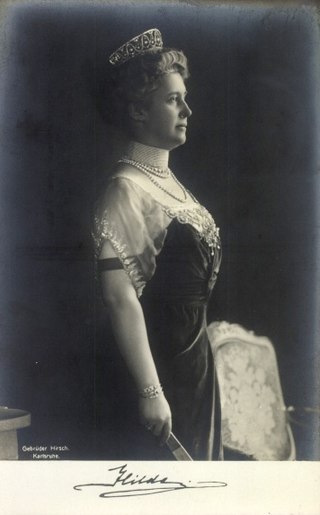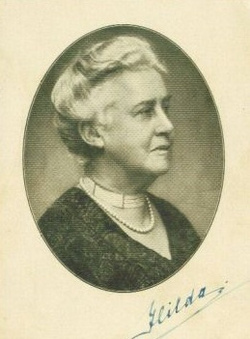We've already met one Hilda from the Nassau family, but what do you know about her aunt and namesake, the last Grand Duchess of Baden? Today we'll learn more about Hilda of Nassau, the daughter of Grand Duke Adolph and sister of Grand Duke Wilhelm IV.
 |
| Hilda as a child |
Hilda was born on November 5, 1864, at Schloss Biebrich in Wiesbaden, at that time the main residence of the Nassau family. She was the youngest child and only surviving daughter of Adolph, Duke of Nassau and his second wife, Adelheid-Marie of Anhalt-Dessau. She spent her early childhood mostly at Schloss Hohenburg, where she grew up as a cheerful and optimistic child. Hilda remained close to her mother throughout her life, both sharing a deep love of art.
Following the Austro-Prussian War in 1866 and subsequent exile of the Nassau family, Hilda resided in Vienna. She spent much of her time with her mother, visiting museums and artists' studios. While in Vienna Hilda was presented to Austrian Empress Elisabeth, better known as Sissi, who took a shine to the girl, impressed by Hilda's skills at riding horses. An accomplished horsewoman herself, Elisabeth would occasionally take young Hilda out on rides.
Queen Victoria considered Hilda as a bride for one of her younger sons, Arthur or Leopold. Although she was an appealing candidate due to her family connections, no marriage plans materialized. However, an impressive suitor for Hilda did come into the picture around the time of her twentieth birthday.
Friedrich of Baden was the son of Friedrich I, Grand Duke of Baden. Seven years Hilda's senior, Friedrich was also a grandson of German Emperor Wilhelm I through the latter's daughter, Louise. Friedrich studied law and history at the University of Heidelberg, then later in Bonn and Freiburg. His Prussian relatives had an enormous impact on his life, particularly through his devotion to the Prussian military. At the time he met Hilda, Friedrich had been serving in Potsdam as a soldier in the Prussian Army for five years.
By an unusual coincidence, Queen Victoria had also wanted Friedrich to marry into her family. He was Victoria's first choice of a groom for her granddaughter, Elisabeth of Hesse and by Rhine, who later married into the Russian Imperial family.
 |
| Friedrich and Hilda around the time of their wedding |
Hilda became engaged to Friedrich during the spring of 1885. Hilda's aunt, Queen Sophia of Sweden, played a large part in arranging the marriage; her daughter-in-law Victoria was also Friedrich's sister. It is believed that the wealth of Hilda's family made the match even more appealing, as the grand duchy of Baden was not especially rich and an influx of cash from a dowry would go a long way in strengthening its finances. Hilda's dowry was indeed quite large, valued at several million florins. She also had an enormous trousseau comprised of dresses made mostly in Vienna.
Hilda and Friedrich married on September 20, 1885, at Schloss Hohenburg. The ceremony was a lavish one, with hundreds of banners, a long processional, a fireworks display, and scores of guests. The marriage was seen in part as a sort of compensation for Adolph following the loss of the Duchy of Nassau in 1866. A high-profile marriage of his daughter to an important German prince meant that Adolph was accepted again among greater German royalty. A great banquet was held after the wedding as a symbolic means of welcoming Adolph and his family back into the fold. Hilda and Friedrich honeymooned in one of Adolph's villas in Alt-Aussee, Austria.
The new couple's entrance into the city of Freiburg in 1886 was met with great fanfare. A tower known as the Hilda Tower (Hildaturm) was constructed to commemorate the occasion. The Hilda Tower was used during World War II as an observation tower for the threat of incoming enemy planes. The tower is still a well-known attraction in Freiburg.
.jpg) |
| The Hilda Tower |
Friedrich's military duties left Hilda with considerable free time. While the couple had planned for children, they were never able to have a family of their own. Instead, Hilda often passed the time by visiting her brother Wilhelm and his family at Schloss Hohenburg, as well her parents during their stays at Königstein. Hilda was close to all six of her Luxembourg nieces, and as a result her visits became more frequent due to the long illness of her brother Wilhelm starting in 1898. Hilda was also present at Schloss Hohenburg when her father died in November 1905.
Friedrich inherited the Grand Duchy of Baden upon the death of his own father in September 1907. He had resigned from his duties in the Prussian Army five years prior when his father began to show signs of ill health. The couple, however, still remained closely tied to the military of the German Empire due to their familial associations. Hilda christened the SMS Nassau, the Imperial Navy's first dreadnought battleship, in March 1908.
 |
| Hilda as Grand Duchess of Baden |
The 1910s were difficult years for Hilda. She lost her brother Wilhelm in 1912 after complications from a brain hemorrhage years before. Two years later, World War I broke out and devastated much of Europe. Hilda devoted herself during the war years to managing the efforts of the Red Cross within Baden.
Hilda's beloved mother Adelheid-Marie died in 1916. Finally, at the close of the war in November 1918, the German monarchies were overthrown. Karlsruhe broke out in riots, forcing Hilda, Friedrich, and his sister Victoria - then Queen of Sweden, who was visiting at the time - to flee the palace for their lives. Through Victoria's connections, the family eventually arrived at Schloss Langenstein, the home of Swedish Count Robert Douglas. On November 22, 1918, Friedrich abdicated the grand ducal throne of Baden, renouncing it for himself and his successors.
In 1920, the couple settled into Schloss Sickingen in Freiburg as their winter home, while spending summers in Badenweiler. As Hilda and Frederick did not have children of their own, Friedrich informally adopted his distant cousin Bertold as his titular successor in Baden in 1927. Frederick was experiencing many health problems during this time, which he sought to treat at the area's numerous baths. Hilda was a devoted caregiver to her husband, who spent his final years nearly blind. Friedrich died in August 1928 after years of deteriorating health.
 |
| Hilda in her later years |
Hilda faced a long widowhood. She continued to live on at Freiburg and Königstein, where her surviving Luxembourg nieces were frequent visitors. She remained close to Bertold and was present at his wedding to Theodora of Greece (an older sister of Prince Philip, Duke of Edinburgh) in 1931.
Life during World War II was again quite difficult for Hilda. She was cut off from most of her beloved Luxembourg nieces, several of whom had been forced to flee Germany for North America or other parts of Europe. Her youngest niece Sophie unexpectedly died in 1941 following a short illness. In November 1944, Schloss Sickingen was destroyed in an Allied bombing raid. Hilda lost nearly all of her possessions amid the destruction.
By 1951, Hilda realized that her time was coming to an end. Due to to war and its aftermath she had been unable to visit Königstein in twelve years. After declaring that she wished to see her beloved home one last time, she, accompanied by an entourage that included her namesake niece, returned to Königstein for a few weeks. Hilda was welcomed with open arms and a bouquet of flowers, with the occasion commemorated by speech from the mayor.
Hilda died in Badenweiler on February 8, 1952, just a few months after her 87th birthday. She is buried in the family crypt in Karlsruhe beside her husband Friedrich. Several streets and schools in Karlsruhe are are still named in Hilda's honor.

No comments:
Post a Comment